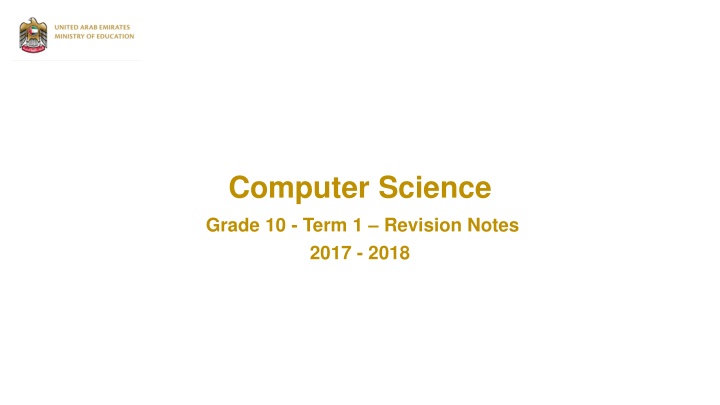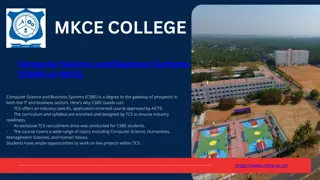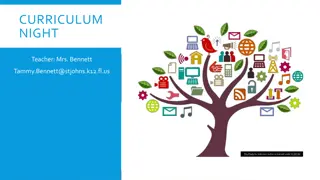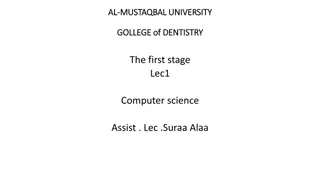
Network Components and Technologies
Discover the essentials of network components like hosts, devices, and media, as well as network technologies such as Wi-Fi, GPS, and NFC. Explore cable types, network connections in mobile phones, and more in this comprehensive guide to computer science Grade 10 term 1 revision notes.
Download Presentation

Please find below an Image/Link to download the presentation.
The content on the website is provided AS IS for your information and personal use only. It may not be sold, licensed, or shared on other websites without obtaining consent from the author. If you encounter any issues during the download, it is possible that the publisher has removed the file from their server.
You are allowed to download the files provided on this website for personal or commercial use, subject to the condition that they are used lawfully. All files are the property of their respective owners.
The content on the website is provided AS IS for your information and personal use only. It may not be sold, licensed, or shared on other websites without obtaining consent from the author.
E N D
Presentation Transcript
Computer Science Grade 10 - Term 1 Revision Notes 2017 - 2018
Unit 2 Networks in our daily life Word Meaning the geographic area in which an individual tower can provide a signal to a phone. Cell the Global Positioning System network uses satellites to transmit signals that cover the globe. an area where wi-fi signals are available. wireless communication technology that helps data exchange by devices very close to each other. technology commonly used in local area networks. hardware that enables the device to connect to the network medium, either wired or wireless. records where each host is located and how it is connected to the network; it shows where the wiring is installed and the locations of the networking devices that connect the hosts. GPS Hotspot NFC (Near Field Communications) Ethernet Network Interface Card (NIC) Physical Topology Diagram Logical Topology it shows the relevant network configuration information, such as IP address. Twisted-pair wires are grouped in pairs and twisted together to reduce interference.
Word Meaning cable used by cable TV companies; made of either copper or aluminium copper. Coaxial Cable can be either glass or plastic; carries digital information at very high speeds over long distances. Fibre-optic Cable source of interference occurs when cables are bundled together for long lengths. Crosstalk type of UTP cable that has the same termination pattern on both ends of the cable. type of UTP cable that has the transmit and receive wires reversed on one end of the cable. Straight Through Cable Cross Over Cable
Mobile Telephones Different types of networks GPS The Global Positioning System network uses satellites to transmit signals that cover the globe. The smart phone can receive these signals and calculate the phone s location to an accuracy of within 10 meters. Wi-fi Wi-fi transmitters and receivers in the smart phone enable the phone to connect to local networks and the internet. In order to receive and send data on a wi-fi network, the phone needs to be within the range of the signal from a wireless network access point. wi-fi networks are usually privately owned but often provide guest or public access hotspots. A hotspot is an area where wifi signals are available. Wi-fi network connections on the phone are like the network connections on a laptop computer. Bluetooth A low-power, shorter-range wireless technology. It is intended to replace wired connectivity for accessories such as speakers, headphones and microphones. Because Bluetooth technology can be used to transmit both data and voice, it can be used to create small local networks. NFC NFC stands for Near Field Communications. NFC is a wireless communication technology. It enables data to be exchanged by devices that are very close to each other, usually less than a few centimeters.
Network Components 1. Hosts send and receive traffic. A host is a generic name for most end-user devices. A host has an IP network address. Examples of hosts are personal computers, network-attached printers and even your phone. 2. Networking devices connect other devices, mainly hosts. These devices move and control network traffic. Examples of network devices are hubs, switches and routers. 3. Network media provides connections between hosts and network devices. Network media can be wired copper or fibre-optic, or use wireless technologies.
Network Interface Card (NIC). This is a network interface card (or NIC) which is required to connect a computer to a network. Each Ethernet NIC has a unique address permanently embedded on the card. It is known as a Media Access Control (MAC) address. A cable is inserted into a connector (or port) on the network interface card so that the computer can be attached to a network. A wireless network interface card can be used to connect a desktop computer to a network. Radio waves are used to provide a link to a wireless
Connecting end-user devices There are three parts to the IP configuration. They must be correct for the device to send and receive information on the network: IP address identifies the host on the network Subnet mask identifies the network on which the host is connected Default gateway - identifies the networking device that the host uses access the internet Commands used to check IP configuration Ipconfig used to display all the IP configuration values Ping to check for the network end-to-end connectivity between two devices.
Manual and automatic address assignment Manual IP configuration and dynamic IP configuration Manual IP configuration With manual configuration, the required values are entered into the device via the keyboard. The IP address entered is referred to as a static address. It is permanently assigned to that device. It never changes unless the admin logins in and changes it. Dynamic IP configuration Most end-user devices can be set up to receive network configuration automatically. This enables the device to request an address from a pool of addresses. They are assigned by a Dynamic Host Configuration Protocol (DHCP) server.
Private and Public addresses There are two types of IP addresses; public and private. Public addresses are addresses which are globally set from your ISP (Internet Service Provider), like Du or Etisalat. Private IP addresses are set by the network administrator for a DCHP server. They are for your internal LAN network. As these are local personal addresses you and your neighbour could share the same private IP address because in theory they are two different networks (two different routers two different houses).
Network topologies and representations Physical and Logical topologies Physical topology When networks are installed, a physical topology diagram is created. It records where each host is located and how it is connected to the network. It also shows where the wiring is installed and the locations of the networking devices that connect the hosts. Such a diagram uses symbols or icons. Logical topology This information cannot be seen from the physical view of the network. The device names, IP addressing, configuration information are logical pieces of information. They may change more often than the physical connectivity.
Logical diagram Draw and label all the parts. Make sure you put the correct media/cables. Learn how to write the IP addresses.
Unit 4 - IPv4 Address and subnet masks A host needs an IPv4 address to work on the internet Every device on the internet has a unique IP address IP addresses are either 32-bit or 128-bit numbers. The 32 bits are grouped into four 8-bit bytes called octets. The address is broken down into four 8-bit numbers (each is called an octet) There are currently two different versions of IP addresses in use IPv4 and IPv6. IPv6 is so much larger than IPv4, It is very difficult for humans to read a binary IPv4 address. For this reason, the 32 bits are grouped into four 8-bit bytes called octets. Each octet is presented as its decimal value, separated by a decimal point or period. This is referred to as dotted-decimal notation. The router is the interface to the internet with the public address. Network Address Translation (NAT) is used to translate between private IPv4 and public IPv4 addresses. This is usually done on the router that connects the internal network to the ISP's network.
Networks and hosts There are two parts to every IPv4 address. How do hosts know which portion is the network and which is the host? This is the job of the subnet mask.
5. Providing Network Services Word Meaning a set of rules and guidelines for communicating data between network devices an internet service which translates domain names into IP addresses Protocol Domain Name System (DNS) a protocol that provides administrators with a secure way to access a remote computer a protocol used for standard electronic mail transmission between servers Secure Shell (SSH) Simple Mail Transfer Protocol (SMTP) an application layer protocol used by local email clients to receive emails from remote server over TCP/IP connection an internet standard protocol used by a client s email to retrieve emails from the mail server over a TCP/IP connection Post Office Protocol (POP) Internet Message Access Protocol (IMAP) a program that uses HTTP to serve the client web pages in response to their requests a standard network protocol on the network; used for the transfer of computer files between client and server Web Server File Transfer Protocol (FTP)
Meaning Word Hyper Text Transfer Protocol is an application protocol for transferring files like text, graphics, images, sound, video and multimedia files. Hyper Text Markup Language is a standard markup language used for creating web pages and web applications a document commonly written in Hyper Text Markup Language; accessible using internet browsers the requesting user or program in a client/ server relationship a computer designed to process the requests from clients and deliver data to clients over a local network or the internet a process-specific or applicationspecific software construct serving as a communication endpoint used by different protocols a numerical number assigned to a specific port; usually a 16-bit unsigned number that ranges from 0 to 65535 Telecommunication Network protocol uses access remote computers over TCP/IP; used to provide bidirectional, interacted, text-oriented communication using virtual terminal connection transmission achieved by converting the electrical signals into light pulses HTTP HTML Web Page Client Server Port Port Number Telnet Optical Signals
Server Job The server typically looks after: Logins and security File handling Printing Internet access
Uniform Resource Locator (URL) The URL identifies the: The protocol that is being used to send the request (this can also be https, or ftp) The folder location on the web server where the resource is stored The actual resource or file that is being requested The domain name is example.com - sent to the DNS server for resolution to an IP address
Domain Name Service (DNS) Each server has an IP address. To access the resource your computer must find the IP address of the server. It finds this using a service called DNS, Domain Name Service.DNS is like a phone book for the internet. DNS working steps is as follows:- Step 1: Request information Step 2: Ask the DNS servers Step 3: Ask the root nameservers Step 4: Ask the authoritative DNS servers Step 5: Retrieve the record
Few Examination Tips - You are given 35 minutes to complete the exam. - Allocate time according to the sections. - Read the questions carefully. - Look for key words in the question like define, explain, list, describe. Answer accordingly. - Do not forget to Label your drawings. - See the marks allotted and answer accordingly. - Do not leave any answer blank. Try to attempt all questions. ALL THE BEST






















